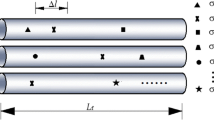Abstract
Defects of polymer-derived Si−C−O fibers were intensively studied by the SEM and TEM techniques and their originations were also discussed on the basis of factors experiments. The defects were found mainly in the form of strumaes, pits and splits on surfaces as well as microflaw networks, porosity clusters and inclusions in the bulk. Factors experiments reveal that a nonuniform or an insufficient curing would result in larger-sized strumaes or interior microflaws. Gas evolution rates due to different firing rates have a great influence on the formation of internal microflaws or porosity clusters and some oxidation-induced pits or splits may be formed on surfaces because of a trace of oxygen or water vapor accumulated from the flowing inert atmosphere during pyrolysis.
Similar content being viewed by others
References
Yajima S, Hayashi J, Omori M,et al. Development of a Silicon Carbide Fiber with High Tensile Strength.Nature, 1976, 261: 683
Sawyer L C, Arons R, Haimbach F,et al. Characterization of Ni-calonTM: Strength, Structure and Fractography.Ceramic Engineering and Science Proceedings, 1985, 6(7): 567
Clark T J, Jaffe M, Rabe J,et al. Thermal Stability Characterization of SiC Fibers: I, Mechanical Property and Chemical Structure Effects.Ceramic Engineering and Science Proceedings, 1986, 7 (7–8): 901
Sawyer L C, Chen R T, Haimabch F,et al. Thermal Stability Characterization of SiC Fibers: II, Fractography and Structure.Ceramic Engineering and Science Proceedings, 1986, 7(7–8): 914
Sawyer L C, Jamieson M, Brikowski D,et al. Strength, Structure and Fracture Properties of Ceramic Fibers Produced from Polymeric Precursors: I, Base-line Studies.Journal of the American Ceramic Society, 1987, 70(11): 798
Chu Z Y, Feng C X, Song Y C,et al. Correlations between Flaw types and Flaw Sizes and the Average Tensile Strength of Polymer-derived SiC Fibers.Journal of Iron and Steel Research International, 2002, special issue: 247
Chu Z Y, Song Y C, Xu Y S,et al. Enhanced Irradiation Crosslinking of Polycarbosilane.Journal of Materials Science Letters, 1999, 18(21): 1793
Chu Z Y, Wang Y D, Feng C X,et al. Effect of Spinning Techniques on the Mechanical Properties of Polymer-derived SiC Fiber.Key Engineering Materials, 2002, 224–226: 651
Chu Z Y, Feng C X, Song Y C,et al. Effect of Oxygen Content on the Tensile Strength of Polymer-derived SiC Fibers.Transactions of Nonferrous Metals Society of China, 2002, 12(5): 894
Chu Z Y, Feng C X, Song Y C,et al. Influence of Water-vaporcontaining Atmosphere on the Pyrolysis of Polymer-derived SiC Fibers. In: Krenkel W, Naslain R, Schneider H, Eds.High Temperature Ceramic Matrix Composites. Weinheim, Germany: 2001, 41
Author information
Authors and Affiliations
Additional information
CHU Zeng-yong: Born in 1974.
Funded by National Advanced Materials Committee of China (715-011-016)
Rights and permissions
About this article
Cite this article
Zeng-yong, C., Chun-xiang, F., Yong-cai, S. et al. Defects of polymer-derived Si−C−O fibers and their originations. J. Wuhan Univ. Technol.-Mat. Sci. Edit. 19, 36–40 (2004). https://doi.org/10.1007/BF02838359
Received:
Accepted:
Issue Date:
DOI: https://doi.org/10.1007/BF02838359




